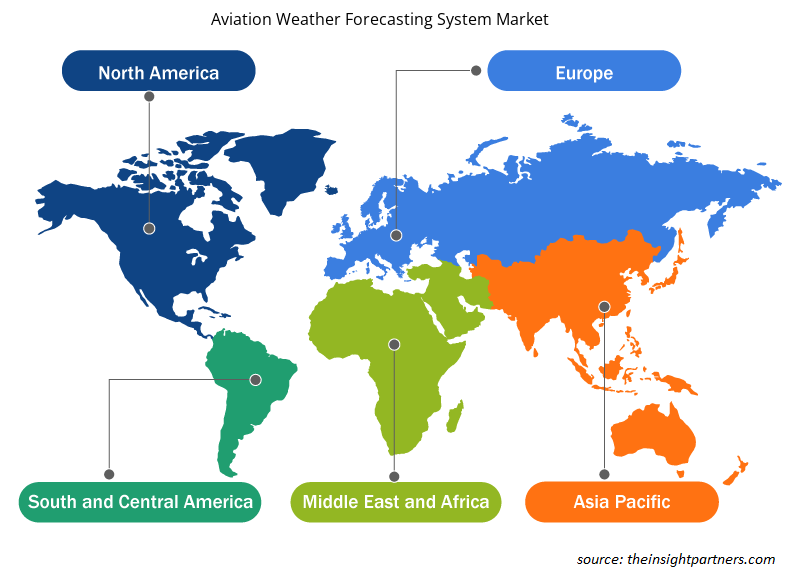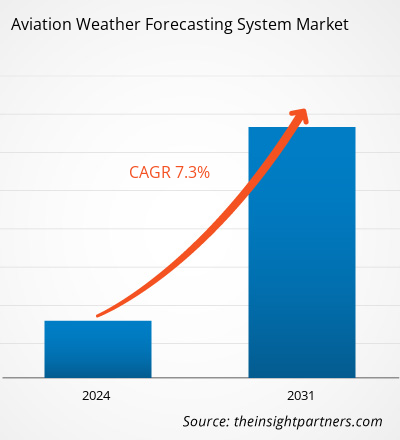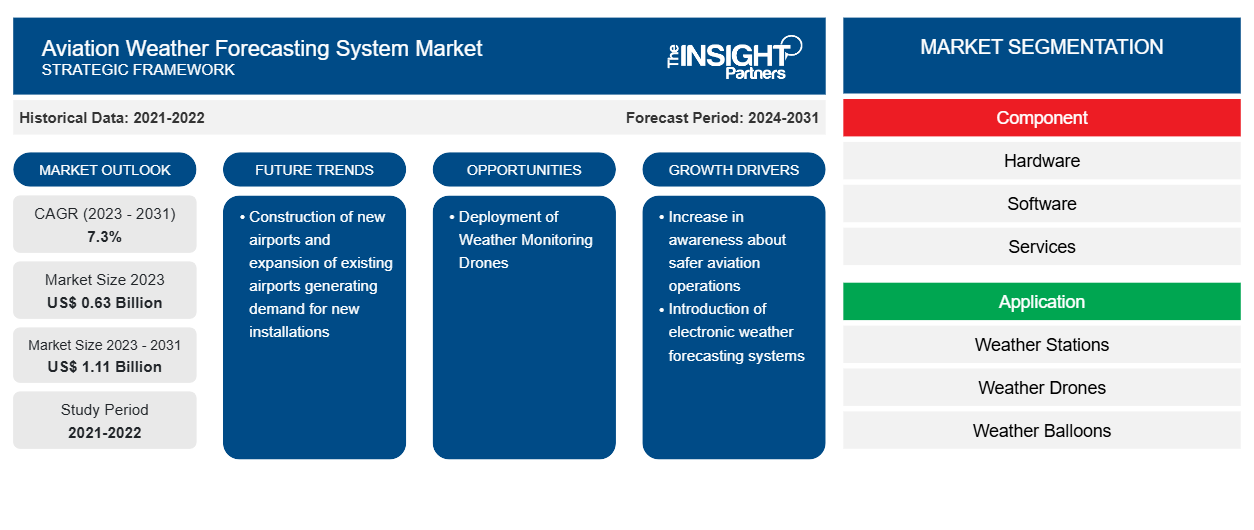Le marché des systèmes de prévision météorologique pour l'aviation devrait atteindre 1,11 milliard USD d'ici 2031, contre 0,63 milliard USD en 2023. Le marché devrait enregistrer un TCAC de 7,3 % au cours de la période 2023-2031. La construction de nouveaux aéroports et l'agrandissement des aéroports existants, générant une demande de nouvelles installations, devraient rester une tendance clé du marché.
Analyse du marché des systèmes de prévision météorologique pour l'aviation
Collins Aerospace, ENAV SpA, IBM Corporation, Vaisala et Campbell Scientific Inc. figurent parmi les principaux acteurs du marché mondial des systèmes de prévision météorologique pour l'aviation. Le marché est fortement consolidé et plusieurs acteurs de premier plan répondent à la demande nationale et internationale. Selon l'étude de marché sur les systèmes de prévision météorologique pour l'aviation, ces acteurs acquièrent cumulativement une part plus importante du marché mondial des systèmes de prévision météorologique pour l'aviation par rapport aux autres entreprises.
Aperçu du marché des systèmes de prévision météorologique pour l'aviation
Les acteurs du système de prévision météorologique pour l'aviation comprennent à la fois des fabricants de matériel et des fournisseurs de logiciels qui dépendent les uns des autres. Les fabricants de matériel et les fournisseurs de logiciels sont Collins Aerospace, IBM Corporation, Campbell Scientific Inc, Sutron, DTN, Spire Global, Universal Weather and Aviation Inc, Vaisala, Ubimet et bien d'autres. Le marché des systèmes de prévision météorologique pour l'aviation compte de nombreux petits acteurs engagés dans cette activité qui détient une part importante du marché mondial. Les petits acteurs sont également impliqués dans des activités de R&D pour développer les nouvelles technologies qui renforceront encore la taille du marché au cours des prochaines années. Au fil des ans, ces organisations ont augmenté leurs investissements dans le développement de systèmes de prévision météorologique pour l'aviation nouveaux et avancés en fonction des besoins croissants des clients avec l'aide des organismes de réglementation gouvernementaux. L'organisme de réglementation gouvernemental aide les fabricants de matériel et les fournisseurs de logiciels du système de prévision météorologique pour l'aviation en fournissant le contrat à l'aéroport militaire et aux aéroports commerciaux.
Personnalisez ce rapport en fonction de vos besoins
Vous bénéficierez d'une personnalisation gratuite de n'importe quel rapport, y compris de certaines parties de ce rapport, d'une analyse au niveau des pays, d'un pack de données Excel, ainsi que de superbes offres et réductions pour les start-ups et les universités.
-
Obtenez les principales tendances clés du marché de ce rapport.Cet échantillon GRATUIT comprendra une analyse de données, allant des tendances du marché aux estimations et prévisions.
Moteurs et opportunités du marché des systèmes de prévision météorologique pour l'aviation
Introduction des systèmes électroniques de prévision météorologique
L'introduction et l'adoption de systèmes électroniques liés aux prévisions météorologiques poussent les fournisseurs du marché à développer des produits innovants et à répondre à la demande croissante. En outre, plusieurs aéroports prennent des initiatives pour installer des systèmes de surveillance météorologique électronique sur leurs pistes et dans les locaux de l'aéroport afin d'obtenir des opérations plus sûres dans l'ensemble des installations. Par exemple, en janvier 2024, l'aéroport de Salida-Harriet Alexander Field (KANK) au Colorado a annoncé l'ouverture et le fonctionnement de son nouveau système météorologique électronique de pointe qui lui permet de mener des opérations d'atterrissage plus sûres à l'aéroport et d'avoir une meilleure idée des conditions aériennes à l'aéroport.
Déploiement de drones de surveillance météorologique
Les drones météorologiques sont spécialement conçus pour voler dans la couche la plus basse de l'atmosphère terrestre (la couche limite) et sont équipés de capteurs permettant de collecter des informations sur la température, le vent, l'humidité, les orages et la pression atmosphérique dans l'atmosphère. Le déploiement de drones pour collecter des données météorologiques est l'un des principaux facteurs qui devraient générer d'énormes opportunités pour les fournisseurs du marché au cours de la période de prévision. Ces drones sont équipés de capteurs thermodynamiques qui collectent les données météorologiques telles que l'humidité, la pression et la température et les transmettent aux stations météorologiques. Les systèmes de prévision en temps réel peuvent utiliser ces données dans les aéroports. Le système de prévision en temps réel utilise ensuite les données pour fournir des prévisions météorologiques et des mises à jour pour les environnements de trafic aérien. Plusieurs organisations travaillent actuellement sur des systèmes de collecte de données de drones plus efficaces pour obtenir des systèmes de surveillance météorologique par drone plus fiables qui peuvent être utilisés pour fournir des données plus précises et en temps réel pour les systèmes de prévision météorologique dans l'ensemble de l'industrie aéronautique.
Analyse de segmentation du rapport sur le marché des systèmes de prévision météorologique pour l'aviation
Les segments clés qui ont contribué à l’élaboration de l’analyse du marché des systèmes de prévision météorologique pour l’aviation sont les composants, l’application et le type de prévision.
- En fonction des composants, le marché des systèmes de prévision météorologique pour l'aviation est segmenté en matériel, logiciels et services. Le segment du matériel détenait une part de marché plus importante en 2023.
- En fonction des applications, le marché des systèmes de prévision météorologique pour l'aviation est segmenté en stations météorologiques, drones météorologiques, ballons météorologiques et autres. Le segment des stations météorologiques détenait une part de marché plus importante en 2023.
- En fonction du type de prévision, le marché des systèmes de prévision météorologique pour l'aviation est segmenté en courte, moyenne, longue et longue portée. Le segment à courte portée détenait une part de marché plus importante en 2023.
Analyse des parts de marché des systèmes de prévision météorologique pour l'aviation par zone géographique
La portée géographique du rapport sur le marché des systèmes de prévision météorologique pour l’aviation est principalement divisée en cinq régions : Amérique du Nord, Europe, Asie-Pacifique, Moyen-Orient et Afrique et Amérique du Sud.
L'Amérique du Nord a dominé le marché en 2023, suivie de l'Europe et de la région Asie-Pacifique. En outre, l'Asie-Pacifique devrait également connaître le TCAC le plus élevé dans les années à venir. Deux des pays les plus peuplés de la région Asie-Pacifique, à savoir la Chine et l'Inde, ont déjà annoncé leurs projets futurs de construction de nouveaux aéroports. Par exemple, en 2023, le gouvernement indien a annoncé son intention de construire 80 nouveaux aéroports dans le pays d'ici la fin de 2025. De même, la Chine a également annoncé son intention de construire 216 nouveaux aéroports d'ici la fin de 2035. Cela devrait en outre stimuler l'installation de systèmes de prévision météorologique pour l'aviation dans la région Asie-Pacifique dans les années à venir.
Aperçu régional du marché des systèmes de prévision météorologique pour l'aviation
Les tendances régionales et les facteurs influençant le marché des systèmes de prévision météorologique pour l’aviation tout au long de la période de prévision ont été expliqués en détail par les analystes d’Insight Partners. Cette section traite également des segments et de la géographie du marché des systèmes de prévision météorologique pour l’aviation en Amérique du Nord, en Europe, en Asie-Pacifique, au Moyen-Orient et en Afrique, ainsi qu’en Amérique du Sud et en Amérique centrale.

- Obtenez les données régionales spécifiques au marché des systèmes de prévision météorologique pour l'aviation
Portée du rapport sur le marché des systèmes de prévision météorologique pour l'aviation
| Attribut de rapport | Détails |
|---|---|
| Taille du marché en 2023 | 0,63 milliard de dollars américains |
| Taille du marché d'ici 2031 | 1,11 milliard de dollars américains |
| Taux de croissance annuel composé mondial (2023-2031) | 7,3% |
| Données historiques | 2021-2022 |
| Période de prévision | 2024-2031 |
| Segments couverts |
Par composant
|
| Régions et pays couverts |
Amérique du Nord
|
| Leaders du marché et profils d'entreprises clés |
|
Densité des acteurs du marché des systèmes de prévision météorologique pour l'aviation : comprendre son impact sur la dynamique commerciale
Le marché des systèmes de prévision météorologique pour l'aviation connaît une croissance rapide, tirée par la demande croissante des utilisateurs finaux en raison de facteurs tels que l'évolution des préférences des consommateurs, les avancées technologiques et une plus grande sensibilisation aux avantages du produit. À mesure que la demande augmente, les entreprises élargissent leurs offres, innovent pour répondre aux besoins des consommateurs et capitalisent sur les tendances émergentes, ce qui alimente davantage la croissance du marché.
La densité des acteurs du marché fait référence à la répartition des entreprises ou des sociétés opérant sur un marché ou un secteur particulier. Elle indique le nombre de concurrents (acteurs du marché) présents sur un marché donné par rapport à sa taille ou à sa valeur marchande totale.
Les principales entreprises opérant sur le marché des systèmes de prévision météorologique pour l'aviation sont :
- Campbell Scientific Inc
- Collins Aérospatiale
- Société IBM
- Société Sutron
- Vaisala
- Météo et aviation universelles Inc.
Avis de non-responsabilité : les sociétés répertoriées ci-dessus ne sont pas classées dans un ordre particulier.

- Obtenez un aperçu des principaux acteurs du marché des systèmes de prévision météorologique pour l'aviation
Actualités et développements récents du marché des systèmes de prévision météorologique pour l'aviation
Le marché des systèmes de prévision météorologique pour l'aviation est évalué en collectant des données qualitatives et quantitatives après des recherches primaires et secondaires, qui comprennent d'importantes publications d'entreprise, des données d'association et des bases de données. Quelques-uns des développements sur le marché des systèmes de prévision météorologique pour l'aviation sont énumérés ci-dessous :
- Un partenariat entre le Met Office, FLYHT Aerospace Solutions Ltd. (TSX-V : FLY) (OTCQX : FLYLF) et Loganair vise à améliorer la précision des prévisions météorologiques et la prévision des phénomènes météorologiques violents localisés au Royaume-Uni, avec des avantages attendus pour l'industrie aéronautique tels qu'une planification d'itinéraire plus efficace et le soutien aux objectifs de réduction des émissions de CO2. (Source : Met Office, communiqué de presse, août 2023)
- L'Empresa Argentina de Navegación Aérea a annoncé l'achèvement des opérations d'installation de trois nouveaux systèmes automatiques d'observation météorologique (AWOS) dans les aéroports de San Miguel de Tucumán, San Salvador de Jujuy et Salta Argentina. (Source : Empresa Argentina de Navegación Aérea, communiqué de presse, janvier 2022)
Rapport sur le marché des systèmes de prévision météorologique pour l'aviation : couverture et livrables
Le rapport « Taille et prévisions du marché des systèmes de prévision météorologique pour l’aviation (2021-2031) » fournit une analyse détaillée du marché couvrant les domaines ci-dessous :
- Taille et prévisions du marché des systèmes de prévision météorologique pour l'aviation aux niveaux mondial, régional et national pour tous les segments de marché clés couverts par le champ d'application
- Tendances du marché des systèmes de prévision météorologique pour l'aviation ainsi que la dynamique du marché, comme les facteurs déterminants, les contraintes et les opportunités clés
- Analyse détaillée des cinq forces de Porter
- Analyse du marché des systèmes de prévision météorologique pour l'aviation couvrant les principales tendances du marché, le cadre mondial et régional, les principaux acteurs, les réglementations et les développements récents du marché
- Analyse du paysage industriel et de la concurrence couvrant la concentration du marché, l'analyse de la carte thermique, les principaux acteurs et les développements récents pour le marché des systèmes de prévision météorologique pour l'aviation
- Profils d'entreprise détaillés
- Analyse historique (2 ans), année de base, prévision (7 ans) avec TCAC
- Analyse PEST et SWOT
- Taille du marché Valeur / Volume - Mondial, Régional, Pays
- Industrie et paysage concurrentiel
- Ensemble de données Excel
Rapports récents
Témoignages
Raison d'acheter
- Prise de décision éclairée
- Compréhension de la dynamique du marché
- Analyse concurrentielle
- Connaissances clients
- Prévisions de marché
- Atténuation des risques
- Planification stratégique
- Justification des investissements
- Identification des marchés émergents
- Amélioration des stratégies marketing
- Amélioration de l'efficacité opérationnelle
- Alignement sur les tendances réglementaires























 Obtenez un échantillon gratuit pour - Marché des systèmes de prévision météorologique pour l'aviation
Obtenez un échantillon gratuit pour - Marché des systèmes de prévision météorologique pour l'aviation